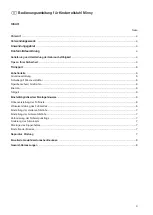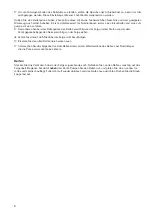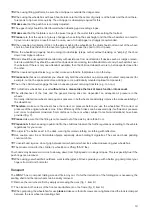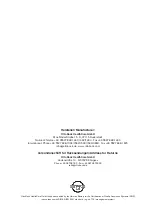
15
strain on the casters, thus increasing the maneuverability of the wheelchair. This makes tilting the wheelchair on two
wheels easier, and steps can be more easily cleared.
Moving the seating shell towards the front increases the total stability of the wheelchair.
Please note:
If the seating shell is adjusted to the very back of the wheelchair and the user‘s body is not appro-
priately positioned, the wheelchair may become tippy even on flat ground.
Use of an anti-tipper is absolutely required for this.
Changing the seat angle
For therapeutic reasons, individual adjustment of the angle of the seating shell may be required. In order to adjust the
seat angle, change the position of the front or rear seat attachment (see above).
Mounting the Anti-tipper
Place the anti-tipper onto the designated receiver and make sure that the spring button (fig. 12, item A) is locked in
the desired bore hole.
Setting the wheel lock
The wheel lock has been correctly mounted, if the distance x (fig. 7, item A) between the tires and the wheel lock bolts
is max. 5 mm (subject to technical changes). Check the tire air pressure and the effectiveness of the locking device
regularly. The maximum air pressure is 9 bar.
Please only use the original driving wheels in order to make sure that the brakes work.
Repair, Maintenance
The MINNY children‘s wheelchair has been provided with the CE sign.
The manufacturer herewith guarantees that this medical product as a whole conforms to the requirements of 93/42/
EEC Guideline.
Should problems with your wheelchair arise, please contact the responsible wheelchair supplier.
To clean the wheelchair, use a mild detergent.
Some components of the wheelchair need to be serviced from time to time to ensure smooth operation.
Hair or dirt particles may accumulate between the caster wheel and fork making it difficult for the caster wheels to
rotate.
Remove the caster wheel and thoroughly clean the fork and caster wheels using a mild detergent.
If the wheelchair gets wet, towel dry it as soon as possible.
Do not use the wheelchair in salt water, and keep sand or other particles from damaging the wheel bearings.
Check the tightness of all screw connections regularly. If a screw connection continually comes loose or is dam-
aged, consult your wheelchair supplier.
To maintain the operating performance of the wheelchair, the spokes of the rear wheels should be checked and
re-tightened approx. once a year. This adjustment should be made by your supplier.
If you should have a flat, you can repair it yourself with a little skill and suitable tools. In case of an emergency, always
have a spare tire and air pump at hand.
If you have a flat, remove the tire from the rim by carefully pulling the tire from the opposite side of the valve.
Be sure not to damage the rim.
Replace the old tire with the new one.
Before re-mounting the tire, inspect the inner rim surface and the inside of the tire for any object that may have
caused the flat.
Tires
Stick the valve through the designated hole in the rim. Now push the tire carefully over the rim surface. Start
next to
the valve. Inflate the tire and check if it is lying without folds and in the center. If not, let some air out and realign the
tire. Tighten the dust cap.




































